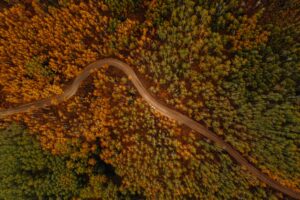Is Profitable Reforestation Possible? Land Life Company Makes the New 50 to Watch List
In the face of the climate crisis, we are seeing a new generation of innovators rising to the task and developing high-impact solutions to tackle the world’s most pressing challenges. These entrepreneurs are creating new technologies and business models that could change every aspect of how we live – from what we eat to how we consume, from how we build our homes to our relationship with Nature. After a decade of success with our Global Cleantech 100, we are launching 50 to Watch, an annual program built to surface and honor these early-stage companies that are fighting the good fight.
 A Solution in Focus
A Solution in Focus
We are thrilled to announce that Land Life Company has a place on our inaugural 2019 50 to Watch list. Land Life specializes in giving life back to degraded land, and offering large companies a full reforestation service. We talked to Jurriaan Ruys, its Founder and CEO, to hear more.
An Interview with Jurriaan Ruys, Co-founder and CEO of Land Life Company
Cleantech Group: What global challenge made you want to start Land Life Company?
Jurriaan: Two billion hectares of land is degraded globally, which is the size of the United States and China combined. This is a result of fires, or intense deforestation and abandoned agricultural land.
Very few resources are going into bringing that nature back. Our mission is to help restore these two billion hectares of land.
When we started this company, I was still a partner at McKinsey, and had done a lot of work in Cleantech. I was also on the board of Eneco, and had worked a lot on renewable energy. The problem was well on its way to get solved, a question of implementation.
For land however, I did not know anybody working on it. How do we treat our soil? How do we treat our planet? With my co-founder Eduard Zanen (who also founded Bugaboo), we believed that this was a risky but exciting topic to tackle. We did not know whether there was a business model, and gave ourselves 2 to 3 years to find one.
It took longer in the end, but a year ago the land element became more mainstream and we started to grow very fast. Today, we are selling more trees than we can plant, and are trying to catch up with demand.
Cleantech Group: What drew you to planting trees, and how was the learning curve?
Jurriaan: When I was with McKinsey, I did pro bono work for the International Union for Conservation of Nature (IUCN). The Director I worked with told me that he was going to quit and start a foundation to restore nature. As an engineer, I was fascinated by the idea of kickstarting nature for it to come back and take its own course. So I stepped on a plane and went to study one of his projects. It was a piece of degraded land in Spain, it was really eye-opening. On the flight back, we wrote two or three pages which could be the start of a business.
pro bono work for the International Union for Conservation of Nature (IUCN). The Director I worked with told me that he was going to quit and start a foundation to restore nature. As an engineer, I was fascinated by the idea of kickstarting nature for it to come back and take its own course. So I stepped on a plane and went to study one of his projects. It was a piece of degraded land in Spain, it was really eye-opening. On the flight back, we wrote two or three pages which could be the start of a business.
The more strategic reason was that degraded land was unchartered territory in business and environmental terms.
And the last reason, which I think everyone can relate to, was how cool it would be to create a company where we travel the world and plant trees in exotic places, like a cross between David Attenborough and Ernest Hemingway. It sounded like a dream!
Cleantech Group: What innovation did you bring to market to address this challenge?
Jurriaan: Our first business model wasn’t viable. With my co-founder’s background creating strollers with Bugaboo, and mine as an engineer, we wanted to build and make something. We started with a product called Cocoon, a doughnut-shaped biodegradable cardboard box which helps the sapling tree survive with water, nutrients, fungi to help the tree survive, etc. Although trials went really well, and we hit about a million in revenues in 2017, our main clients, emerging economy governments like Mexico, weren’t easy to do business with and we were struggling to scale and have an impact.
That’s when we changed our business model to become an end-to-end reforestation. We had noticed that a lot of issues happen before the planting, with bad seedlings for instance. Some of our clients, like Apple, forced us to do the reforestation end-to-end. We were nervous at first, but the basics of planting trees are feasible. We saw a lot of opportunity for improvement in end-to-end. A whole new market was emerging, with corporates looking for the end product, telling their consumers that they had invested in the planet on their behalf.
 Now, we use state-of-the art agricultural technologies to plant land, including satellite data and drones to create a map to decide where to plant which tree. We evaluate exposition, slope, where the rainwater runs, whether we are on clay or sand. This blueprint is then given to a robot, who has a cassette of about 130 seedlings, the robot uses the map to dig a hole in the right spot, adds nutrients and then plants the optimal tree for that location.
Now, we use state-of-the art agricultural technologies to plant land, including satellite data and drones to create a map to decide where to plant which tree. We evaluate exposition, slope, where the rainwater runs, whether we are on clay or sand. This blueprint is then given to a robot, who has a cassette of about 130 seedlings, the robot uses the map to dig a hole in the right spot, adds nutrients and then plants the optimal tree for that location.
We now know where we planted each tree and track their growth with drones and satellites. We can see what worked and what didn’t. You can also give the data to your customers, and they can have a sense of ownership. We have never lost a tender since!
Cleantech Group: What kind of land do you typically work with?
Jurriaan:We work with federal land. There are a lot of failed projects in reforestation, we believe it is because the risks were too high. When deforestation is still going strong, like in Africa or Brazil, the risk that your tree will not survive 50 or 60 years is high. We started with low-risk regions: Australia, US and Europe. We work with governments who have identified a piece of land as protected. We hope in the meantime the world sees we need to protect more land.
Could you walk us through an example project?
Jurriaan: When we start a project, in Spain for instance, our first discussion is with the local juntas. Smaller organizations of people who own the land near where they live. These are mostly abandoned agricultural land that suffered wildfires. You do business with the mayor and the few people remaining in the village. They were incredulous at first, but we kept coming back every season with more trees to plant, and the word spread to the Province, and we now talk with Madrid.

All that is left is to then allocate trees to customers. At some point, we sign a contract to agree that these trees will stay in place between 40 and 70 years, and that we have the right to sell the CO2 credits. With those contracts in hand, we start the project and look for local tree nurseries and contractors to do the labor. 60% of the money we receive from companies is re-invested in local communities.
Cleantech Group: How do you decide what species to plant?
Jurriaan: In the beginning we were guided by local universities, and over the years we have formed our own opinion of what works where. This year we hired a top agriculture professor from a Dutch agricultural university. He joined because he believes we are running the largest field experiment ever conducted. Indeed, we are planting 1 million trees a year, and tracking their growth. That’s unprecedented.
We hope that our work, our trial and error will build big data on trees and eventually decrease the cost of reforestation.
Cleantech Group: How do you measure the impact you are generating?
Jurriaan: We are for-profit and do make returns, but every investor understands that we are impact-focused first. We measure hectares restored, CO2 captured, number of trees, as well as positive impact on water balances, and social impact from the investment in the local communities.
 The communities we work with are almost always disadvantaged communities. The rich never lives next to degraded land. I call it ecological socialism: we need to share access to nature just like we are sharing money. Living next to degraded land impacts happiness levels, and, taken to an extreme, can cause societal issues like migrations or civil wars.
The communities we work with are almost always disadvantaged communities. The rich never lives next to degraded land. I call it ecological socialism: we need to share access to nature just like we are sharing money. Living next to degraded land impacts happiness levels, and, taken to an extreme, can cause societal issues like migrations or civil wars.
Cleantech Group:Tell us about your business model and goals. How do you plan to grow over the next few years?
Jurriaan: Today companies come to us for a carbon offset, in which case we charge a carbon price. We tend to charge significantly higher than others for offsets, because we have a high-quality product, and we can’t save the world by charging $1/ton of CO2. Our price point is around 15 – 25 euros. Then it’s our job to spend less than that and continue to invest in our growth.
However, we may not plant the tree immediately. On the one hand, we have too much demand, and on the other we have to adapt to natural conditions. A drier spring means we will be able to plant fewer trees. Our customers understand that the problem runs into decades, that it’s a long-term project. Some of them don’t even want to talk about CO2 credits, they just wish to tackle a specific issue like wildfire reforestation.
Cleantech Group: Have you seen other organizations with a similar business model?
Jurriaan: Not enough. Many of our customers tell us they can’t find reforestation organizations that have the same fact-based approach as we do. Some companies have good technologies, like shooting seeds from drones. But the end-to-end reforestation, from project to local engagement, I haven’t seen it. To be honest, I don’t like it. We are not able to reforest this world alone. I would like to see similar companies crop up in the next few years.
Cleantech Group: Is there something along the way that almost made you quit?
Jurriaan: Sometimes people ask me, “it must be amazing to do something with a purpose every day?” and I tell them that it is absolutely not the case – I deal with the same s*** that every entrepreneur deals with. We have been through phases when we were concerned about our burn rate, and had to cut costs. Few people realize how hard it is to be a young company. However, when it gets really tough is when you think about the purpose. The need for what we do goes beyond the pains of the day. You don’t quit, because you can’t. This work needs to be done!



